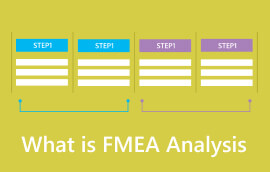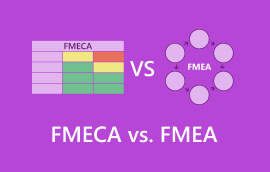What You Need to Know About FMEA: Meaning, Standards, Template, Etc.
In a business, it is vital to have a risk assessment or analysis. The reason is that, in one way or another, they will face risks. Thus, it is also important to identify them and think of a way to manage them. One example of this is the FMECA (Failure Mode, Effects, and Critical Analysis). If you want to use it and you’re new to it, there are details you need to know about it first. And so this post is here to guide you about FMECA analysis. Apart from that, we’ll give you an FMEA template and example.

- Part 1. FMECA Definition
- Part 2. FMECA Standard
- Part 3. Uses of FMECA
- Part 4. FMECA Example and Template
- Part 5. FMEA Tool
- Part 6. FAQs About FMECA Analysis
Part 1. FMECA Definition
FMECA is an acronym for Failure modes, effects, and criticality analysis. It is a method used by industries. The purpose of it is to determine the potential failures in a process, product, or system. After that, know their effects and focus on them based on their criticality. But note that this process doesn't guarantee flawless outcomes. Regardless of your efforts or decision-making, occasional mistakes can still arise. Nonetheless, performing thorough assessments is still essential. Plus, taking appropriate preventive measures can reduce the risks before they occur.
Part 2. FMECA Standard
FMECA doesn't have a single universal standard. Instead, it involves a structured methodology applied across various industries and sectors. These standards outline the steps and procedures to follow when performing FMECA. Further, it ensures consistency and accuracy across different industries and projects. Some referenced standards that provide guidelines for conducting FMECA include:
MIL-STD-1629
This standard is usually used in the military and aerospace industries. It provides a structured method to identify potential failures in systems. Then, it assesses their effects and prioritizes them based on how critical they are. It also includes steps like defining the system and analyzing potential failures. Finally, it evaluates their consequences.
IEC 60812
It focuses on ways to analyze and present reliable data in a systematic way. It emphasizes the importance of collecting and interpreting data. That way, you'll know the potential failures. At the same time, assess these risks in an effective way.
SAE JA1011/1012
These standards are from the Society of Automotive Engineers (SAE). They offer guidelines for performing FMECA in the automotive industry. They also provide detailed procedures for analyzing failure modes. Then, they assess their effects and establish risk mitigation strategies.
ISO 9001
While not specifically for FMECA, ISO 9001 sets general quality management standards. It is a standard applicable to various industries. It highlights the importance of risk management and continual improvement. Thus aligning them with the principles of FMECA.
Part 3. Uses of FMECA
In this part, check out the key uses of the FMECA:
1. Identify Potential Failures
FMECA can help determine and list all the failures that may occur in a product, system, and more. It identifies failure modes, whether in a car engine, computer system, and more.
2. Understanding Impact
FMECA helps in understanding what happens if those failures actually occur. For example, if a machine breaks down, how much damage could it cause? How would it affect productivity or safety?
3. Prioritizing Risks
It also helps in deciding which failure modes are the most critical. That way, you can use the resources focused on resolving the most important ones first.
4. Enhance Reliability
FMECA isn’t all about just preventing problems or potential failures. It is also about making a product or system more reliable. Understanding potential failures allows for improvements to make things work.
5. Improve Design and Reliability
FMECA also assists you in designing better systems by identifying weak points early. By doing this, you will be able to make improvements. Thus, you can prevent failures before systems are even built.
Part 4. FMECA Example and Template
Let’s check out an example of FMECA analysis below.
FMECA Example - Car Engine Failure Analysis
In a car engine failure analysis using FMECA, we identify potential failure modes. Next, we will determine their effects. Then, prioritize these failure modes for mitigation. Let's consider some common failure modes in a car engine.
Component: Piston
Function: Moves up and down in the cylinder.
Failure Mode: Seizure (getting stuck due to lack of lubrication).
Component: Fuel Injector
Function: Sprays fuel into the cylinders.
Failure Mode: Clogging (obstruction hindering fuel flow).
Component: Spark Plug
Function: Ignites the fuel-air mixture.
Failure Mode: Fouling (accumulation of deposits affecting ignition).
Component: Cooling System
Function: Regulates engine temperature.
Failure Mode: Coolant Leak (leakage leading to overheating).
Now, below is a visual presentation of the effects and prioritization of this FMECA analysis.

Get a detailed FMECA of the car engine.
Also, you can use this template to create your own FMECA analysis.

Get a detailed FMECA template.
Part 5. FMECA Tool
With various tools available online, it’s hard to choose the best FMECA table creator. Not only that, it can also be challenging to find a reliable one. Hence, we recommend you use MindOnMap. It is a web-based program that lets you create diagrams, tables, and more. It stands out as one of the top mind-mapping software to draw all your ideas. What’s more interesting is that you can also use it as an FMECA tool. It helps you visualize your analysis by letting you create a structured diagram for it. Apart from that, it offers several templates that you can use. These templates include treemaps, fishbone diagrams, organizational charts, flowcharts, and more. Plus, it provides unique icons, shapes, themes, styles, etc., to personalize your work.
Furthermore, MindOnMap lets you insert links and pictures to make your chart more intuitive. The tool also has an automatic saving feature. That means it will save your work after you stop operating on the platform. Thus, it prevents you from losing any crucial data. Moreover, the platform’s easy-sharing feature lets you share your work with others. At the same, they’ll get an idea after seeing your work. As mentioned, MindOnMap is a web-based tool, yet it also has an app version. If you prefer the downloadable software, download it by clicking the button below. Now, start creating your analysis with this FMECA software!
Secure Download
Secure Download

Further Reading
Part 6. FAQs About FMECA Analysis
What is the difference between FMEA and FMECA?
When we say FMEA, it means Failure Mode and Effects Analysis. It focuses on identifying potential failure modes and their effects on systems or products. FMECA stands for Failure Modes, Effects, and Criticality Analysis. So, it expands upon FMEA by adding criticality assessment. It focuses on the failure modes based on their effects and criticality.
Which programs use the FMECA concept?
Many industries use FMECA concepts, such as aerospace, automotive, military, and manufacturing companies.
What are the benefits of FMECA?
FMECA offers several benefits for industries. These include increased asset integrity and reliability, improved compliance, risk reduction, and more.
Conclusion
In conclusion, here’s what you need to know about the FMECA analysis. Also, with the provided template and example, it’s easier to understand the analysis now. If you need a dependable tool to create your desired FMECA analysis table, use MindOnMap. With its straightforward way of making a diagram, it’s suitable for any type of user.










